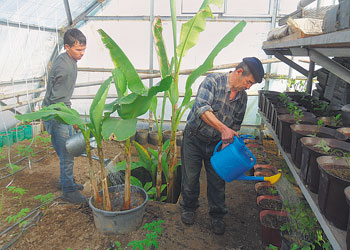SOUTH KAZAKHSTAN – Fruit trees bananas, persimmons and pomegranates are flourishing at the Saryagash Zher Syiy plant nursery in southern Kazakhstan.

Even palm trees could be found at the Zher Syiy plant nursery in South Kazakhstan.
“It is not a commercial project and there will be very few farmers willing to start the commercial cultivation of bananas. But the seedlings of persimmon, pomegranate and lemon fruit are already in demand,” he said.
The nursery uses advanced technologies. The plants are grown in hydroponic pods, drip irrigation is installed and the greenhouse is warmed by special heaters designed by Nikolai Khramov. Soon, Shyntasov plans to expand the project and build more greenhouses.
“We need additional 55 hectares (135.9 acres) of land for further development,” Shyntasov said. “We want the nearby areas to increase production and offer new varieties of seeds.”
The Saryagash Zher Syiy is currently dealing with a large order: A businessman from the neighboring Kazygurt district decided to plant his land with 70,000 seeds of the Starkrimson winter breed of apples.
In 2012, Shyntasov constructed a vegetable storage silo where the required temperature could be set and then used it to store crops and seeds.
Already, that young orchard is yielding 60 tons of fruits per hectare (2.47 acres) this year. In 2012, its first crop of apples yielded almost 20 tons per hectare
A few years ago, Saryagash Zher Syiy bought 17,000 of grape dwarf rootstocks in France. A special sprinkler was installed to provide climatic conditions similar to the French climate. With proper care, the plants will last up to 15 years.
The nursery is an example of the effective cooperation of horticulture and viticulture. The farm grows world famous varieties of apples and also local ones.
“We have developed various schemes for green house horticulture,” Shyntasov said. “The best option, I believe, is when 2,500 bushes are planted on one hectare. Naturally, we use drip irrigation to save resources and reduce labour costs. The state now subsidizes this kind of commercial horticulture only if a drip irrigation system is installed. The legally stipulated minimum area of the nursery is five hectares (12.35 acres). I think it is too small and inefficient, the cost of irrigation and electricity will only be recouped over far too long a period.”
Shyntasov wants to unite all nurseries in the country and establish a national association coordinated by the Kazakh Research Institute of Horticulture and Viticulture. Southern Kazakhstan has all the necessary conditions to develop this kind of agriculture, he said. The Saryagash Zher Syiy needs more land to open a demonstration garden and nursery and plant saplings of different varieties to change popular attitudes about these kinds of crops.
Today the nursery is already growing seedlings of apple, apricot, plums, pears, peaches, cherries, grapes, lemons, persimmons, pomegranates, bananas, junipers, arborvitae, willows, and Japanese quinces. Southern Kazakhstan can look forward to a fruitful future.


